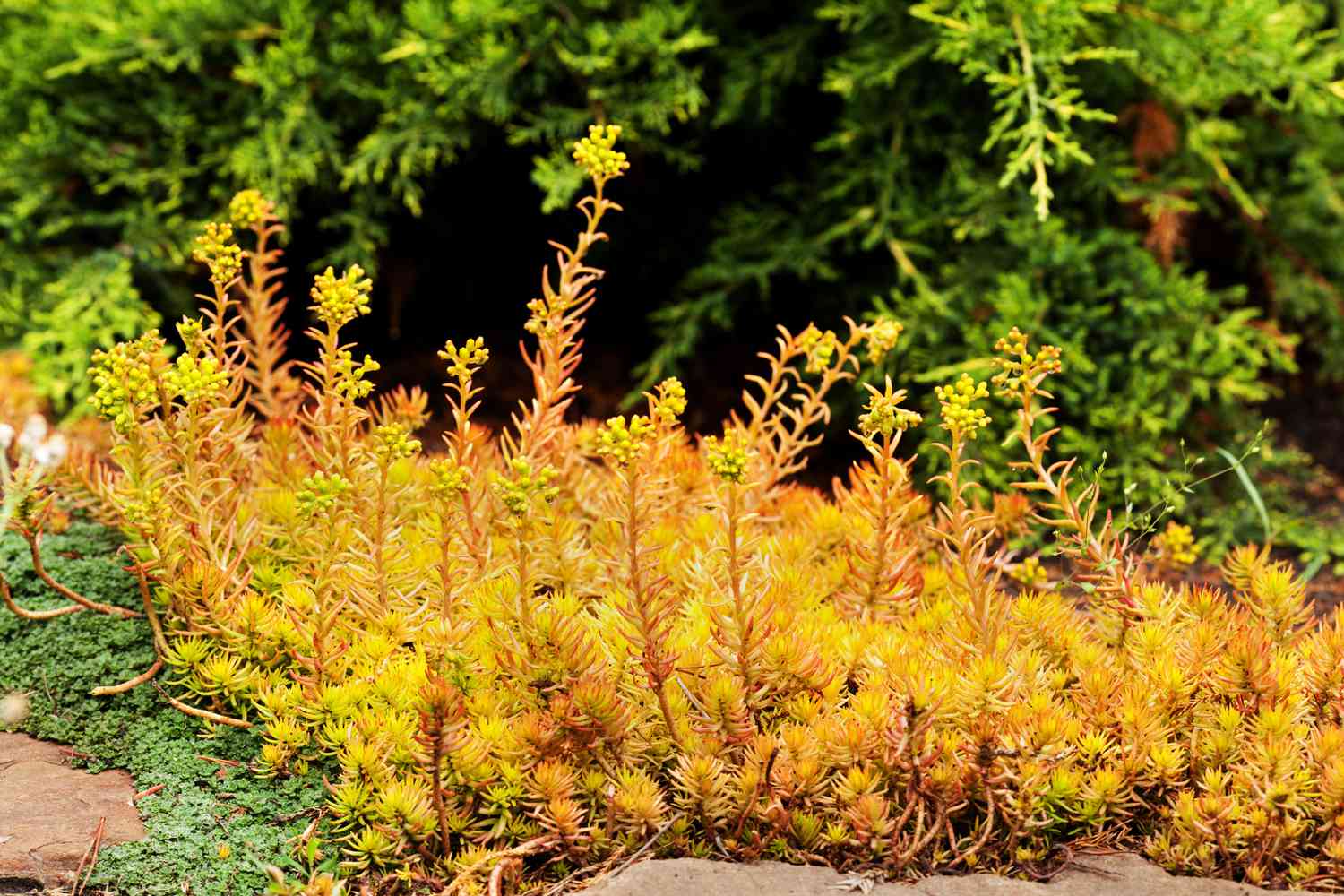
12 Drought-Resistant Ground Covers For Easy Landscaping
Ground covers are true gems in the garden. They provide a soft green backdrop throughout the year so the rest of your plants can take center stage. Some ground covers become a highlight themselves when they burst into bloom and create large swaths of color. The best ground covers are as tough as they are beautiful, demanding little care or water. They spread with ease to beat out weeds and keep your garden looking lush.
If you’re in search of drought-tolerant ground covers that require little upkeep, look no further. Get some inspiration from our list of the best ground-hugging plants for sun and shade.
Hardy Ice Plant
Nataliia_Melnychuk / Getty Images
- Botanical Name: Delosperma
- Sun Exposure: Full sun
- Soil Type: Well-drained, sandy
- Soil pH: Acidic, neutral (6.0 to 7.0)
Sandy, rocky soil and extreme heat will never phase ice plant, which originates from Africa. This ground cover will bloom all summer and fall with little care from you. In fact, ice plant must have very good drainage and suffers if it is overwatered or fertilized. Plant it along sandy paths or at the edge of your rock garden. Hybrid ice plant is winter hardy in USDA Plant Hardiness Zones 5 to 8—though this plant should be avoided in California, where it is invasive.
Epimedium
ULADZIMIR ZGURSKI / Getty Images
- Botanical Name: Epimedium
- Sun Exposure: Dappled sun; full to part shade
- Soil Type: Average, dry to medium, well-draining
- Soil pH: Acidic to neutral (5.0-7.0)
Epimedium is also known by the whimsical names bishop’s hat, barrenwort, and fairy wings. This plant is one of the few that flowers prolifically in dry shade—even under trees. You can also plant it in a location with morning sunlight. Epimedium flowers in shades of white, yellow, pink, or rusty red; some varieties have colorful foliage. Epimedium is a slow spreader and hardy in Zones 5 to 8.
Blue Leadwort
Paroli Galperti/REDA / Getty Images
- Botanical Name: Ceratostigma plumbaginoides
- Sun Exposure: Full sun, partial shade
- Soil Type: Well-drained, sandy, loamy
- Soil pH: Acidic, neutral, alkaline (6.1-7.5)
Also called hardy plumbago or dwarf plumbago, this ground cover grows about 6 inches tall and bears blue flowers in summer and early fall. This plant prefers sandy or loamy soil that is on the dryer side. Blue leadwort is reliably hardy in Zones 6 to 9 and can spread aggressively.
Liriope
Natasha Sioss/Moment Open/Getty Images
- Botanical Name: Liriope spp.
- Sun Exposure: Full, partial, shade
- Soil Type: Well-drained
- Soil pH: Neutral, acidic (6.0-7.0)
Liriope, or lily turf, will grow almost anywhere in the South. Sun, shade, dry or moist soil—it doesn’t much care as long as the ground isn’t soggy. This grass-like, evergreen plant is often used to edge paths, stabilize slopes, and fill areas where not much else will grow. You can also plant it as a lawn alternative.
Creeping Juniper
- Botanical Name: Juniperus horizontalis
- Sun Exposure: Full sun
- Soil Type: Well-drained, sandy, rocky
- Soil pH: Acidic, neutral (5.5-7.0)
Creeping juniper is a North American shrub that performs well as a ground cover on sunny slopes, forming a dense mat from 6 to 18 inches tall. This evergreen must have good drainage but doesn’t require much else. You can find varieties with green, blue, gold, or chartreuse foliage. Some are tinged with purple in winter.
Creeping Thyme
Laszlo Podor/Moment/Getty Images
- Botanical Name: Thymus serpyllum
- Sun Exposure: Full sun
- Soil Type: Well-drained, sandy, loamy, rocky
- Soil pH: Acidic, neutral (6.5-7.5)
Creeping thyme produces a carpet of flowers in summer and has a wonderful, savory scent the rest of the year. This ornamental thyme can be used to fill in the sandy spaces between stepping stones or crevices in rock walls. Some gardeners even use it as a lawn alternative in dry, sunny spots. Plants may rot away with too much rain or watering.
Lamb’s Ear
Lynne Brotchie/Photolibrary/Getty Images
- Botanical Name: Stachys byzantina
- Sun Exposure: Full, partial
- Soil Type: Average, well-draining
- Soil pH: Acidic to slightly alkaline (6.0-7.8)
Fuzzy lamb’s ear will spread throughout your garden in the right conditions, creating a silvery-blue ground cover about 6 inches tall. One-foot stalks with lavender flowers appear in summer. Lamb’s ear does best with good drainage and can struggle during humid summers.
Sedum
speakingtomato / Getty Images
- Botanical Name: Sedum
- Sun Exposure: Full, partial
- Soil Type: Well-draining
- Soil pH: Acidic to neutral (6.0-7.0)
Sedum can be found in a variety of textures and colors. Plant a patchwork of sedums for a multi-colored, mat-forming groundcover. Some, like the ‘Angelina’ pictured above, will change color in fall. Sedum prefers well-draining or sandy soil in a sunny spot. You can easily root the stems in new areas of the garden.
Snow-In-Summer
- Botanical Name: Cerastium tomentosum
- Sun Exposure: Full, partial
- Soil Type: Well-draining, sandy
- Soil pH: Slightly acidic to slightly alkaline (6.5-7.5)
Snow-in-summer’s name comes from the carpet of white flowers it produces in summer. This Italian native prefers dry, sandy soil in full sun. The plant thrives with cooler temperatures and won’t do well in the hot, humid summers of the Coastal South. Plant it in Zones 3-7.
Winecups
Getty Images
- Botanical Name: Callirhoe involucrata
- Sun Exposure: Full sun, partial shade
- Soil Type: Well-draining
- Soil pH: Slightly acidic (6.0 to 6.5)
Also known as purple poppy mallow, winecup is a pretty native flower that becomes drought-tolerant once established thanks to its taproot. This plant goes dormant in winter and sometimes dies back during the heat of summer after it blooms. Winecup forms a 6-inch mat and will self-seed. Grow it in Zones 4 to 8.
Yarrow
- Botanical Name: Achillea spp.
- Sun Exposure: Full, partial
- Soil Type: Well-drained, sandy
- Soil pH: 4.5-8.0
Yarrows originate from North America, Europe, and Asia, with many hybrids available. Some types top out at 1 foot tall or less, making yarrow a good ground cover for dry, sunny areas. Yarrow grows in Zones 3 to 9 and can be evergreen in warmer climates. This pollinator-friendly plant may spread aggressively in the right conditions.
Catmint
Neil Holmes/Oxford Scientific/Getty Images
- Botanical Name: Nepeta x faassenii
- Sun Exposure: Full, partial
- Soil Type: Well-drained
- Soil pH: Acidic, neutral, alkaline (5.0-7.5)
As a member of the mint family, blue catmint has aromatic foliage and a tendency to spread. This plant also blooms repeatedly in spring and summer if you shear off the flowers. Plant it in well-draining soil along a sunny path or rock wall where you can enjoy it. Cats may be drawn by it, but the deer will stay away.










